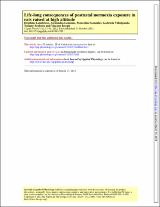Mostrar el registro sencillo del ítem
Life-long consequences of postnatal normoxia exposure in rats raised at high altitude
| dc.contributor.author | Lumbroso, Delphine | |
| dc.contributor.author | Lemoine, Alexandra | |
| dc.contributor.author | Gonzales, Marcelino | |
| dc.contributor.author | Villalpando, Gabriela | |
| dc.contributor.author | Seaborn, Tommy | |
| dc.contributor.author | Joseph, Vincent | |
| dc.date.accessioned | 2021-05-24T18:09:51Z | |
| dc.date.available | 2021-05-24T18:09:51Z | |
| dc.date.issued | 2012 | |
| dc.identifier.uri | http://repositorio.umsa.bo/xmlui/handle/123456789/25261 | |
| dc.description.abstract | Abstract. We tested the hypothesis that exposure of high-altitude (HA) rats to a period of postnatal normoxia has long-term consequences on the ventilatory and hematological acclimatization in adults. Male and female HA rats (3,600 m, PO2 100 Torr; La Paz, Bolivia) were exposed to normal room air [HA control (HACont)] or enriched oxygen (32% O2; PO2 160 Torr) from 1 day before to 15 days after birth [HA postnatal normoxia (HApNorm)]. Hematocrit and hemoglobin values were assessed at 2, 12, and 32 wk of age. Cardiac and lung morphology were assessed at 12 wk by measuring right ventricular hypertrophy (pulmonary hypertension index) and lung air space-to-tissue ratio (indicative of alveolarization). Respiratory parameters under baseline conditions and in response to 32% O2 for 10 min (relieving the ambient hypoxic stimulus) were measured by whole body plethysmography at 12 wk. Finally, we performed a survival analysis up to 600 days of age. Compared with HACont, HApNorm rats had reduced hematocrit and hemoglobin levels at all ages (both sexes); reduced right ventricular hypertrophy (both sexes); lower air space-to-tissue ratio in the lungs (males only); reduced CO2 production rate, but higher oxygen uptake (males only); and similar respiratory frequency, tidal volume, and minute ventilation. When breathing 32% O2, HApNorm male rats had a stronger decrease of minute ventilation than HACont. HApNorm rats had a marked tendency toward longer survival throughout the study. We conclude that exposure to ambient hypoxia during postnatal development in HA rats has deleterious consequences on acclimatization to hypoxia as adults. | es_ES |
| dc.language.iso | en | es_ES |
| dc.publisher | J Appl Physiol. | es_ES |
| dc.subject | DESARROLLO | es_ES |
| dc.subject | PULMONES | es_ES |
| dc.subject | RESPIRACIÓN | es_ES |
| dc.title | Life-long consequences of postnatal normoxia exposure in rats raised at high altitude | es_ES |
| dc.type | Article | es_ES |

